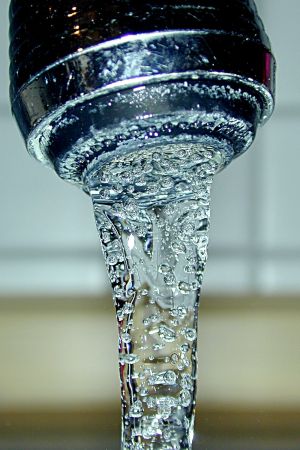Liquid facts for kids
A liquid is a special kind of matter. It's different from a solid or a gas. Liquids have a set amount of space they take up (their volume), but they don't have their own shape. Instead, they always take the shape of the container they are in. Think about pouring water into a glass – it fills the glass!
Liquids can easily change their shape by flowing. This is because the tiny molecules that make up a liquid can move around freely. If a liquid flows very slowly, we say it has high viscosity. For example, honey flows much slower than water, so honey has a higher viscosity. Some liquids, like tar, are so thick they almost look like a solid!
It's hard to squeeze a liquid into a smaller space. If you cool a liquid down enough, it will turn into a solid. This temperature is called the melting point. For water, the melting point is around 0°C (32°F), and it turns into ice. If you heat a liquid up enough, it will turn into a gas. This temperature is called the boiling point. For water, the boiling point is 100°C (212°F), and it turns into steam. Common liquids you see every day include water, oils, and blood.
In a liquid, the parts at the top push down on the parts underneath. This means the pressure is greater at the bottom of a liquid than at the top. This is why when you dive deep in a swimming pool, you can feel the water pushing on you more. The amount of pressure depends on how deep you are and how heavy the liquid is. How heavy a set amount of liquid is called its density. Different liquids have different densities.
Contents
How We Use Liquids
Liquids are super useful in many ways! We use them to make things slippery, to dissolve other things, and to keep things cool. They are also important for moving power around in machines.
Liquids as Lubricants

Have you ever put oil on a squeaky door hinge? That's using a liquid as a lubricant! Lubricants like oil help parts move smoothly against each other. They reduce friction and wear. Oils are often used in engines, gear boxes, and hydraulic systems. They are chosen based on how thick they are (their viscosity) and how well they flow at different temperatures.
Liquids as Solvents
Many liquids are used as solvents. This means they can dissolve other liquids or solids. For example, water is a great solvent. It can dissolve sugar or salt. Solvents are found in many products like paints, sealants, and adhesives (glues). Industrial cleaners often use liquids like Naphtha and acetone to remove grease and tar. Even the fluids inside your body are mostly water-based solutions!
Surfactants, which are found in soaps and detergents, help water clean things better. Liquids like alcohol are also used to kill germs, which is why they are in hand sanitizers. They are also used in cosmetics, inks, and even in the food industry to get things like vegetable oil from plants.
Liquids for Cooling
Liquids are good at taking away extra heat. This is because they can transfer heat better than gases and they can flow. When something gets too hot, we can channel a liquid through it to carry the heat away. This heat can then be released using a heat exchanger, like a radiator in a car. Or, the heat can be removed when the liquid evaporates.
For example, water or glycol coolants keep car engines from getting too hot. In nuclear reactors, water or liquid metals like sodium are used to cool the core. When you sweat, the sweat evaporates from your skin, taking heat away and cooling you down. In air conditioning systems, liquids like water move heat from one area to another to keep buildings cool.
Liquids in Power Systems
Liquids are key parts of hydraulic systems. These systems use liquids to transmit power. They work based on Pascal's law, which says that pressure applied to a liquid in a closed container is transmitted equally throughout the liquid.
Since ancient times, devices like pumps and waterwheels have used liquid motion to do mechanical work. Today, oils are pushed through hydraulic pumps. This force is then sent to hydraulic cylinders, which can lift heavy things or apply strong pressure. You can find hydraulics in many places, like car brakes, heavy construction equipment, and even airplane control systems. Hydraulic presses are used in factories for lifting, pressing, and shaping materials.
Liquids in Measuring Devices
Sometimes, liquids are used in tools that measure things. A thermometer often uses a liquid like mercury or colored alcohol. When the temperature changes, the liquid expands or shrinks, and its level shows you the temperature. A manometer uses the weight of a liquid to measure air pressure.
Images for kids
-
The formation of a spherical droplet of liquid water minimizes the surface area, which is the natural result of surface tension in liquids.
-
A lava lamp contains two immiscible liquids (a molten wax and a watery solution) which add movement due to convection. In addition to the top surface, surfaces also form between the liquids, requiring a tension breaker to recombine the wax droplets at the bottom.
-
Surface waves in water
-
A simulation of viscosity. The fluid on the left has a lower viscosity and Newtonian behavior while the liquid on the right has higher viscosity and non-Newtonian behavior.
See also
 In Spanish: Líquido para niños
In Spanish: Líquido para niños







